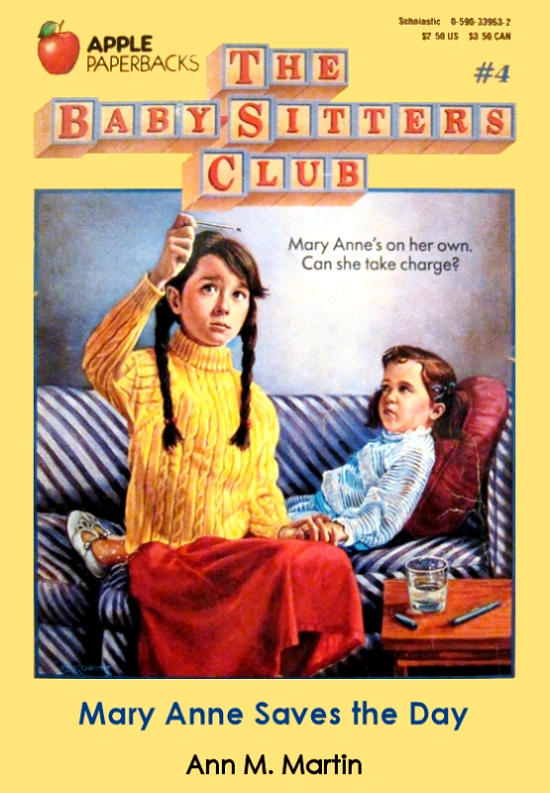The Overprotective Richard Spier (A Baby-Sitters Club Nostalgia Post)
I have been writing a lot of Baby-sitters Club nostalgia posts recently. I did a few when I first started writing this blog, and in recent times, I've started writing them again. The reasoning is pretty simple--those books were a huge part of my life during my pre-teen years and, consequently, I remember the books quite well. (Especially as I read many of them more than once.) One of the strange things about revisiting things from my childhood, though, is that I tend to look at them with a more well, discerning eye. It's easier to see the flaws, but I loved the books so much that I really don't care that the main characters seemingly repeated eighth grade several times over or that we're supposed to believe that their adventures included winning the lottery (well, okay, they won second prize which was just enough to cover the cost seven airline tickets to California,) being shipwrecked on an island (okay, Claudia and Dawn were shipwrecked,) and well, you get the idea.
One thing that always stood out in the series, though, was Mary Anne's family situation. Of all the characters, her situation is undeniably the saddest. Her mother passed away when she was only a baby, and her father, though a caring man is a hardworking lawyer with his own firm who has little time to spend with his daughter. When the series opens, we learn that Mary Anne is the character who has to return home from club meetings to an empty house, and who occasionally has to rely on Claudia's grandmother, Mimi, for guidance. Mary Anne is portrayed as being fairly quiet and shy. Initially, the books were intended to be a four part series, with Mary Anne Saves the Day as the final instalment. It is fitting that Mary Anne should go last, as out of all the characters, she initially seems to be the least mature. She is portrayed as a bit of a cry baby, and even comes across as a little bit scared of Claudia and Stacey. In the first three novels, we learn that though he is often absent, Richard Spier, also somewhat overprotective of his daughter. His many rules include a restrictive dress code for his daughter, one that seems almost laughable by contemporary standards--Mary Anne must always wear dresses or skirts, and penny loafers and her hair must be styled in two braids. In 1987, when the book was initially released, Mary Anne's outfits probably would have been considered a bit childish (I think the word babyish is used in the book.) In this era, fashion for preteens was all about bold and bright colours. It would have been quite typical for a twelve year old girl to wear jeans and a big, colourful sweater, while penny loafers and braids would not have looked out of place on a girl of about eight.
Mary Anne Saves the Day tells the story of how Mary Anne finds a way to stand up to her father, in between two other main plots of how she gets caught in a fight with the other members of the BSC and makes a new friend when Dawn moves to Stoneybook. (Eventually, Mary Anne settles the fight with the other girls, and introduces Dawn to the BSC.) As the series continues, we watch as Mary Anne grows and changes, eventually becoming the most mature and emotionally stable member of the BSC, though she remains prone to tears on more than one occasion. It is, arguably, one the best of the early books, and perhaps a turning point in the series, because we see the club expand for the first time and there is a hint that Mary Anne's family situation may change. It also contains the first hint that Mary Anne and Kristy's friendship is going to change and that this pair of childhood friends may be growing apart. Later, of course, both girls move out of Bradford Court and into new homes and new family sitauations. Dawn becomes Mary Anne's best friend and stepsister, while Kristy finds a friend in her new neighbour Shannon and later a best friend in Abby, the last of the main characters to join the series.
Mary Anne Saves the Day tells the story of how Mary Anne finds a way to stand up to her father, in between two other main plots of how she gets caught in a fight with the other members of the BSC and makes a new friend when Dawn moves to Stoneybook. (Eventually, Mary Anne settles the fight with the other girls, and introduces Dawn to the BSC.) As the series continues, we watch as Mary Anne grows and changes, eventually becoming the most mature and emotionally stable member of the BSC, though she remains prone to tears on more than one occasion. It is, arguably, one the best of the early books, and perhaps a turning point in the series, because we see the club expand for the first time and there is a hint that Mary Anne's family situation may change. It also contains the first hint that Mary Anne and Kristy's friendship is going to change and that this pair of childhood friends may be growing apart. Later, of course, both girls move out of Bradford Court and into new homes and new family sitauations. Dawn becomes Mary Anne's best friend and stepsister, while Kristy finds a friend in her new neighbour Shannon and later a best friend in Abby, the last of the main characters to join the series.
Going back to Mr Spier, and his role as the overprotective dad in Mary Anne Saves the Day, what on earth would inspire any parent to enforce such a strict dress code on his child? As the story unfolds, the reader is left with the impression that Mr Spier is quite a good-hearted man. We learn that he came from a poor background, worked his way through college and then law school, became a successful lawyer who has his own firm, and was left devastated when his wife died from cancer when Mary Anne was still a baby. His background, and the fact that he is now a widower leads him to become fearful that someone will try to take his daughter away, so he went a little overboard trying to make his daughter appear as prim and proper as possible. But why a dress code?
At a guess, I'd say that it was something that readers in the target audience could understand. It gives us a chance to know that Mary Anne's father is overprotective, but in a stuffy and well meaning kind of a way, rather than there being any hint that he is a mean and/or bitter man. It means that readers in the target audience can hate him--or perhaps laugh at him a little--without actually fearing the character. It means we can cheer for both Mary Anne and her father, when they finally reconcile. Another thing I was left with a sense of is that Mr Spier doesn't make decisions based on what other parents do--he makes them based on what he thinks is sensible.
Later in the series we learn that there is more to the story of Mary Anne and her father. It's such an important development for the character that is surprises me that it was made a story in the spin-off Mystery Series rather than being a book in the main series. We learn that after the death of his wife, a grieving Richard makes a rash decision to allow Mary Anne to live with her mother's parents Iowa. It is a decision that he later regrets and quite deeply so, though it takes quite a heartbreaking legal battle for him to regain custody of his daughter, and the fallout is such that Mary Anne never sees or visits her grandparents again, until after the death of her grandfather. This visit is mentioned briefly at the end of Mary Anne and the Secret in the Attic, and in detail in Mary Anne's instalment in the Portrait Collection.
As faithful readers of the series will know, Mary Anne's father married Dawn's mother in Mary Anne and the Great Romance. The pair were opposites, and loved one another because of their differences, but this often made things hard on the kids, who had to get used to being part of such an eccentric family, with Mary Anne and Richard staying firmly on the sensible side of things, and Dawn, Sharon and Jeff, wanting a more laid back lifestyle. Dawn later left for California to live with her dad and Jeff, but not before she and Mary Anne had a number of disagreements as they tried to settle in to their new situations. Sadly the series would end with the old farmhouse where the family lived burning down, and Mary Anne realising that, yet again, she would have to get used to a new home and situation.
Later in the series we learn that there is more to the story of Mary Anne and her father. It's such an important development for the character that is surprises me that it was made a story in the spin-off Mystery Series rather than being a book in the main series. We learn that after the death of his wife, a grieving Richard makes a rash decision to allow Mary Anne to live with her mother's parents Iowa. It is a decision that he later regrets and quite deeply so, though it takes quite a heartbreaking legal battle for him to regain custody of his daughter, and the fallout is such that Mary Anne never sees or visits her grandparents again, until after the death of her grandfather. This visit is mentioned briefly at the end of Mary Anne and the Secret in the Attic, and in detail in Mary Anne's instalment in the Portrait Collection.
As faithful readers of the series will know, Mary Anne's father married Dawn's mother in Mary Anne and the Great Romance. The pair were opposites, and loved one another because of their differences, but this often made things hard on the kids, who had to get used to being part of such an eccentric family, with Mary Anne and Richard staying firmly on the sensible side of things, and Dawn, Sharon and Jeff, wanting a more laid back lifestyle. Dawn later left for California to live with her dad and Jeff, but not before she and Mary Anne had a number of disagreements as they tried to settle in to their new situations. Sadly the series would end with the old farmhouse where the family lived burning down, and Mary Anne realising that, yet again, she would have to get used to a new home and situation.
Interestingly, a few years ago, Mary Anne Saves the Day was one of the novels that was developed into a graphic novel. The author does a fantastic job of capturing the character and her tricky relationship with her overprotective father. Later again, this was one of the BSC novels that had parts very gently rewritten by the authors. (The plot and narrative remain the same, but apparently the author and publisher decided to remove references to outdated technology to give the series a more timeless feel.) I haven't read the updated version, but I would be interested to know if there were any changes made to Mary Anne's clothing ...




Comments